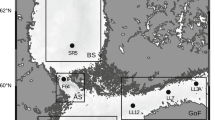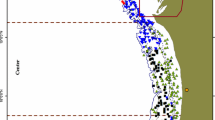Abstract
A relatively simple method is proposed for the estimation of parameters of stage-structured populations from sample data for situation where (a) unit time survival rates may vary with time, and (b) the distribution of entry times to stage 1 is too complicated to be fitted with a simple parametric model such as a normal or gamma distribution. The key aspects of this model are that the entry time distribution is approximated by an exponential function withp parameters, the unit time survival rates in stages are approximated by anr parameter exponential polynomial in the stage number, and the durations of stages are assumed to be the same for all individuals. The new method is applied to four Zooplankton data sets, with parametric bootstrapping used to assess the bias and variation in estimates. It is concluded that good estimates of demographic parameters from stagefrequency data from natural populations will usually only be possible if extra information such as the durations of stages is known.
Similar content being viewed by others
References
Aksnes, D. L. and T. Magnesen (1988) A population dynamics approach to the estimation of production of four calanoid copepods in Lindaspollene, western Norway.Marine Ecology Progress Series 45: 57–68.
Bellows, T. S. and M. H. Birley (1981) Estimating developmental and mortality rates and stage recruitment from insect stagefrequency data.Researches on Population Ecology 23: 232–244.
Breteler, W. C. M. K., N. Schogt and J. van der Meer (1994) The duration of copepod life stages estimated from stage-frequency data.Journal of Plankton Research 16: 1039–1057.
Kempton, R. A. (1979) Statistical analysis of frequency data obtained from sampling an insect population grouped by stages, pp. 401–418. In J.K. Ord, G. P. Patil and C. Taillie (eds.)Statistical Distributions in Scientific Work. International Cooperative Publishing House, Maryland.
Kiritani, K. and F. Nakasuji (1967) Estimation of the stage-specific survival rate in the insect population with overlapping stages.Researches on Population Ecology 9: 143–152.
Manly, B. F. J. (1976) Extensions to Kiritani and Nakasuji’s method for the analysis of stage frequency data.Researches on Population Ecology 17: 191–199.
Manly, B. F. J. (1977) A further note on Kiritani and Nakasuji’s model for stage-frequency data including comments on Tukey’s jackknife technique for estimating variances.Researches on Population Ecology 18: 177–186.
Manly, B. F. J. (1985) Further improvements to a method for analysing stage-frequency data.Researches on Population Ecology 27: 325–332.
Manly, B. F. J. (1987) A regression method for analysing stagefrequency data when survival rates vary from stage to stage.Researches on Population Ecology 29: 119–127.
Manly, B. F. J. (1989) A review of methods for the analysis of stage-frequency data. pp. 3–69. In L. L. McDonald, B. F. J. Manly, J. A. Lockwood and J. A. Logan (eds.)Estimation and Analysis of Insect Populations. Springer-Verlag, Berlin.
Manly, B. F. J. (1990)Stage-Structured Populations: Sampling, Analysis and Simulation. Chapman and Hall, London.
Manly, B. F. J. and A. Seyb (1989) A comparison of three maximum likelihood models for stage-frequency data.Researches on Population Ecology 31: 367–380.
Reed, T. E. (1969) Genetic experience with a general maximum likelihood estimation program, pp. 27–29. In N. E. Morton (ed.)Computer Applications in Genetics.University of Hawaii Press, Honolulu.
Reed, T. E. and W. J. Schull (1968) A general maximum likelihood estimation program.American Journal of Human Genetics 20: 579–580.
Rigler, F. H. and J. M. Cooley (1974) The use of field data to derive population statistics of multivoltine copepods.Limnology and Oceanography 19: 636–655.
Wood, S. N. (1993) How to estimate life history stage durations from stage structured population data.Journal of theoretical Biology 163: 61–76.
Wood, S. N. (1994) Obtaining birth and mortality patterns from structured population trajectories.Ecological Monographs 64: 23–44.
Wood, S. N. and R. M. Nisbet (1991)Estimation of Mortality Rates in Stage-Structured Populations. Springer-Verlag Lecture Notes in Biomathematics 90, Berlin.
Author information
Authors and Affiliations
Corresponding author
Rights and permissions
About this article
Cite this article
Manly, B.F.J. A method for the estimation of parameters for natural stage-structured populations. Res Popul Ecol 39, 101–111 (1997). https://doi.org/10.1007/BF02765255
Received:
Accepted:
Issue Date:
DOI: https://doi.org/10.1007/BF02765255




